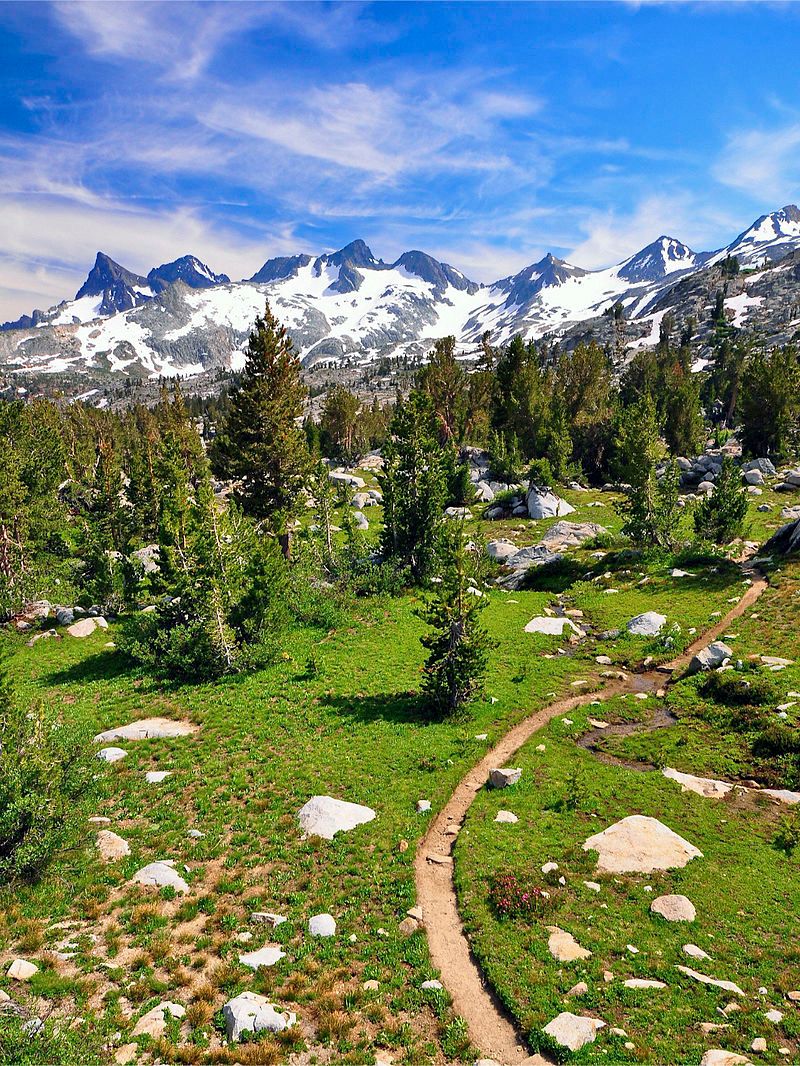Your PCT guidebook – thru-hiking the California Pacific Crest Trail

A few minutes every morning is all you need.
Stay up to date on the world's Headlines and Human Stories. It's fun, it's factual, it's fluff-free.
Have you ever dreamed of pushing your body and your mind to the limit and beyond? This PCT guidebook is a good place to start. Months out on a trail living off the supplies in your backpack will do the job credibly. Think Cheryl Strayed’s 2012 memoir “Wild,” in which she battles her past trauma with a monstrous backpack on her shoulders.
The technical term of Strayed’s adventure is a thru-hike, which is a long end-to-end backpacking journey. The United States has three famous scenic trails for avid thru-hikers: the Appalachian Trail, the Continental Divide Trail and the Pacific Crest Trail. Together they form the Triple Crown of long-distance hiking. If you sweat and bleed your way through all three, you have conquered the holy grail of hiking culture.
The Pacific Crest Trail of the Triple Crown is the ultimate West Coast thru-hike. It begins at the border between the US and Mexico and runs along the Sierra Nevadas and the Cascade Range until weathered boots hit Canadian soil. The Pacific Crest Trail spans over 2,650 miles and travels through three states, but California hosts more than half of those miles. While both Oregon and Washington hold beautiful, pristine wilderness along this scenic trail, California has the best variety of terrain and requires the most planning for a thru-hike. The heat of the Mojave threatens dehydration while the grandiose High Sierra may require snow safety, and most find that Northern California is smooth sailing.
The PCT Association has declared the trail open for business this summer and 2021, though they encourage backpackers to plan for 2022 in order to avoid pandemic-related trouble. If you plan to undertake this transformative experience, then you have to know the terrain, how to be safe (especially if you hold a marginalized identity) and the history behind the trail.
Trail safety
Although trail safety involves a number of topics from proper packing and first-aid to interacting with wildlife, this PCT guidebook focuses on personal safety. Regardless of where you are on the trail, you will find others around you. Day hikers, fellow thru-hikers, trail angels and locals. Womxn or anyone who appears gender-nonconforming must take extra care.
Ignore the people who parrot, “Not all men.” There is a reason many womxn fear men. Imagine three doors. Two lead to a harmless area, but the third leads to certain death. Would you risk certain death by opening one of the doors? No. Why would you risk harm with a strange man on the trail?
Ensure that close friends and family know your approximate location at all times. Carrying a portable charger for a cellphone is an excellent option to ensure regular communication on the trail. Most importantly, trust your instincts. Society often gaslights womxn when they have a bad feeling about a man. Trust yourself. Don’t take chances. Don’t be pressured to hike with someone who you find unsettling.
That being said, this goes for any hiker on the trail. Take care of who you choose to travel with, and be vigilant of strangers at all times. You don’t have to live in fear, but it’s always better to be safe and cautious than sorry. For more extensive safety coverage regarding your PCT thru-hike, check out these safety tips.
Trail history
Just as a great deal of outdoor enthusiasts idealize the enchanting peaks of the Sierra Nevadas, so too do a great many of us associate the High Sierra with John Muir the naturalist. Muir is inextricable from the history of erasure, removal and genocide of Indigenous people, specifically in relation to the theft and renaming of land. If you would like further education on how to respect Indigenous people on your thru-hike, visit @indigenouswomenhike or their website. Their leader, Jolie Varela, advocates for Native women to connect with their ancestral lands and educates others about the history of oppression against Native Americans.
Keep in mind that John Muir followed trade routes created by Indigenous people. The John Muir Wilderness is in fact Nüümü territory. Perhaps the easiest way to encourage others to recognize this history is to post pictures on social media using the correct names for the natural areas. The High Sierra is but one example of white dominance in the wilderness.
Southern California
What better place to begin a daunting test of mental strength and athleticism than the arid allure of Southern California? This section begins in a small town of Campo near the Mexican border and ends at a rite of passage for PCT thru-hikers, Kennedy Meadows, where hikers gather to prepare for the Sierras. These 700 miles will surprise you and leave you forever grateful to have trekked across the desert. Most thru-hikers begin their walk in mid-April or early May.
Backpacker Luis Bautista has the ultimate nugget of knowledge for aspiring thru-hikers: “Nothing will prepare [you] to hike 25 miles a day except hiking 25 miles a day.”
Be prepared for traditional desert weather, but don’t expect a light pack. Though you won’t have winter gear to haul, you’ll have to carry water for extended periods of time to avoid dehydration under the 100 degree days of relentless sun.
While the flat areas of nothing but sand do come around now and again, much of Southern California is mountainous. Be aware that nights in the desert can be chilly, and nights in the desert mountains even more so. You may even encounter snow depending on the time of year.
Central California
Many thru-hikers consider the High Sierra the unequivocal stunner of the entire Pacific Crest Trail. You will travel through idyllic national parks and forests, like Sequoia, Yosemite and Kings Canyon. As a side note, if you love the outdoors, but you can’t imagine tackling the PCT, then check out our guide to California national parks.
The alpine lakes, forests and meadows will entrance you beyond belief. Contemporary language tends to overuse the word “surreal,” but it undoubtedly applies to hiking in the High Sierras. Don’t let the picturesque surroundings lull you into a false sense of security. Make sure you have the proper gear such as microspikes and a pick axe.
Northern California
Consider this the bridge to the rest of your hike. Say goodbye to the Sierras and hello to the Cascade Range. A lot of hikers report experiencing the NorCal blues. The scenery can be a disappointment in comparison to the paradisal expanse of the High Sierra. Northern California can seem like a desert at times, and the lower elevation combined with gradual climbs will make your days seem like a breeze in comparison to the past thousand or so miles. Though perhaps underwhelming at first sight, Northern California has a delicious abundance of flora and fauna. Its beauty is less obvious and more subtle. Here you will reach the midpoint of your hike and continue onto Oregon.
Have a tip or story? Get in touch with our reporters at tips@themilsource.com




Comments ()